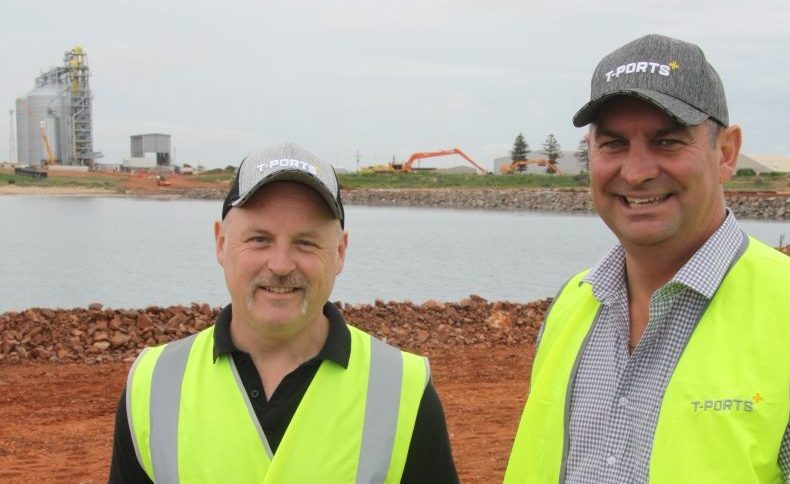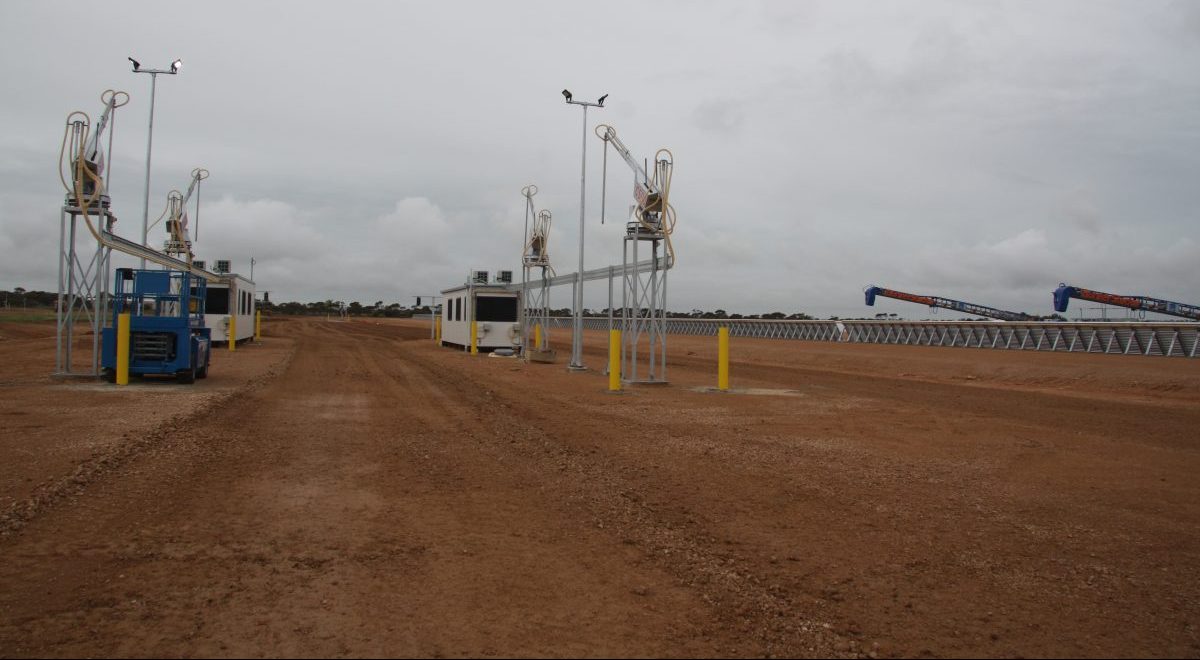
T-Ports’ Mark Antushka and Tim Gurney on the rock causeway being built at Wallaroo to carry grain to the company’s transshipment vessel MV Lucky Eyre.
AS HARVEST gets rolling across the Australian grainbelt, South Australia is ready to greet it with a new export terminal for 2022-23, T-Ports Wallaroo.
The site will supplement capacity at the adjacent Viterra Wallaroo site, and bring new grain-marketing options to growers on the Yorke Peninsula (YP) and Mid North.
In contrast to bulk handlers in New South Wales and Western Australia, who will be receiving new-crop grain with a whopping carryout in hand, SA has run its old-crop stocks down to the wire.
It bodes well for SA growers who are experiencing the price benefits of a level of competition in bulk shipments not evident in NSW and WA, traditionally Australia’s two biggest grain-exporting states.
Lucky Eyre the key
T-Ports is unique in grain exporting, and not just in Australia.
It uses a transshipment vessel, the MV Lucky Eyre, to transfer 3200 tonnes of grain per journey to vessels at anchor in Spencer Gulf, which separates Eyre Peninsula (EP) and YP.
While transshipment is used to export mineral concentrates in northern Australia, T-Ports has introduced it to the Australian grain industry via its foundation terminal, Lucky Bay.
Located on the eastern shore of EP, T-Ports Lucky Bay loaded its first grain cargo in March 2020, and has loaded 43 vessels since.
T-Ports manager business development and client relations Tim Gurney said using transshipment eliminates many marine costs associated with pilots, tugs, and berthing.
“This assists our lower FOB cost structure and attracts grain traders to use our facilities.”
The shallow upper reaches of the Spencer Gulf and neighbouring Gulf of St Vincent have long been a foil to shipping efficiency in SA’s mid to low-rainfall grain-growing zones.
Mr Gurney said Lucky Eyre has for the first time allowed Panamaxes carrying more than 50,000t of grain to take on roughly double the amount of grain they could previously load at terminals north of Port Adelaide and Port Lincoln.
“It’s a game-changer; we only need 4 metres of water to operate.”
It is feeding into SA’s highly competitive elevator margins, or the costs of getting grain on to a ship, which enable SA traders to pay more for grain.
Model decided
Mr Gurney said a virtual duplication of Lucky Bay at Wallaroo shows the trade and growers have confidence in the model.
“Now we’ve proved it works, it’s just a matter of copy and paste.”
Mr Gurney said T-Ports was focused on growing its business model into a range of commodities.
“It doesn’t stop here – while we have started with grain as our initial commodity, there are a range of other opportunities across SA, Australia and globally that would present interest to us.”
While T-Ports is yet to announce its next project, it is rumoured to be looking at WA, where some growers have been critical of the overburdened supply chain and its impact on prices.

Construction at the bunker site at T-Ports Wallaroo is near completion, and first deliveries are expected in coming weeks.
First causeway
Like Mr Gurney, T-Ports general manager of construction Mark Antushka started in SA bulk handling in the 1990s, and the pair are part of an experienced team that is proud to have introduced a new supply chain to the SA grains industry.
Mr Anthushka said building at Wallaroo started in April 2021, and its infrastructure centres on a 500m L-shaped rock causeway which will sit 6m above sea level when completed.
As well as allowing truck access for special requirements, it will support a grain conveyor fed primarily by two 10,000t bins, a duplicate of the Lucky Bay set-up, with adjacent bunkers.
“We’ll be export ready by the middle of next year, and the bunkers themselves are ready now,” Mr Antushka said.
Located across the road from the silos, the six bunkers each have capacity to hold 40,000t of grain, and the site has room to expand.
Latest option
Prior to T-Ports setting up on EP, the region was said to have the cheapest grain in Australia.
With virtually no domestic market or container-packing facilities, all its exports were via EP’s only two export terminals, Port Lincoln and Thevenard.
Both assets are owned and operated by Viterra, which also has two terminals at Port Adelaide, and one each at Port Giles and Wallaroo to export its own and third-party cargoes.
US-based company ADM has been exporting from a Port Pirie berth in recent years, while Viterra has mothballed its nearby facility in favour of shipping out of Port Adelaide.
Cargill’s and Semaphore’s separate facilities at Port Adelaide, and ADM at Port Pirie all use mobile shiploaders to fill hatches with bulk grain.
On top of Viterra’s and T-Ports’ offerings, the combined impact for SA growers is a depth of market that is the envy of many growers in other states.
Roadshow complete
In order to encourage growers to deliver to T-Ports Wallaroo, Mr Gurney has just finished a roadshow of 11 Ag Bureaus spread across YP and the Mid North to explain the T-Ports system, which is accumulating for seven traders.
“Some have got short books; some have got long books – that means a sustainable competitive price throughout the season.”
Those traders include global heavyweight LDC, Victorian-based Flexi Grain, and US-based energy and commodities trader Hartree Partners.
“Growers have now witnessed these changes to market dynamics on both sides of the gulf, with some EP growers saying they’ve benefited upwards of $30/t now that more competition and options are available via T-Ports.
“The Wallaroo zone increased around $20/t within the first week of Hartree Partners posting our first price into T-Ports Wallaroo last week.”
Some traders shipping out of T-Ports accumulate grain outside the T-Ports network, and Mr Gurney said this offers growers further opportunities to deliver grain for out-turn to T-Ports terminals.
“Growers who can’t directly support us out of the paddock can indirectly support us at third-party sites.”
With SA now in the early days of what could well be a record harvest, Mr Gurney has high hopes for T-Ports’ first operational year at Wallaroo.
“We’d hope to fill this year.”
Based on the Lucky Eyre’s capacity to load 120,000t per month, Mr Antushka said it has added 1.4Mt annually of export capacity to South Australia.
“Imagine going into a record crop without that,” Mr Gurney said.
Significant investment
As greenfield sites with a specially built ship to service them, the T-Ports venture has cost $200 million, including $70M for Wallaroo.
Funding came from private non-grower investment and Mr Gurney said the venture would not have been possible without a pledge of support from EP growers, which then enabled T-Ports to court interest from the trade.
“We went around in 2017 and asked for expressions of interest from growers; it gave our investors and buyers an idea of what was coming.”
Despite the 2019 and 2020 EP harvests being lean, T-Ports supplier base has expanded to 300 growers.
Ahead of harvest, T-Ports has doubled its bunker storage capacity at Kimba to 100,000t to supplement capacity at its up-country EP site at Lock which was built to accumulate for Lucky Bay.
Grain Central: Get our free news straight to your inbox – Click here

HAVE YOUR SAY